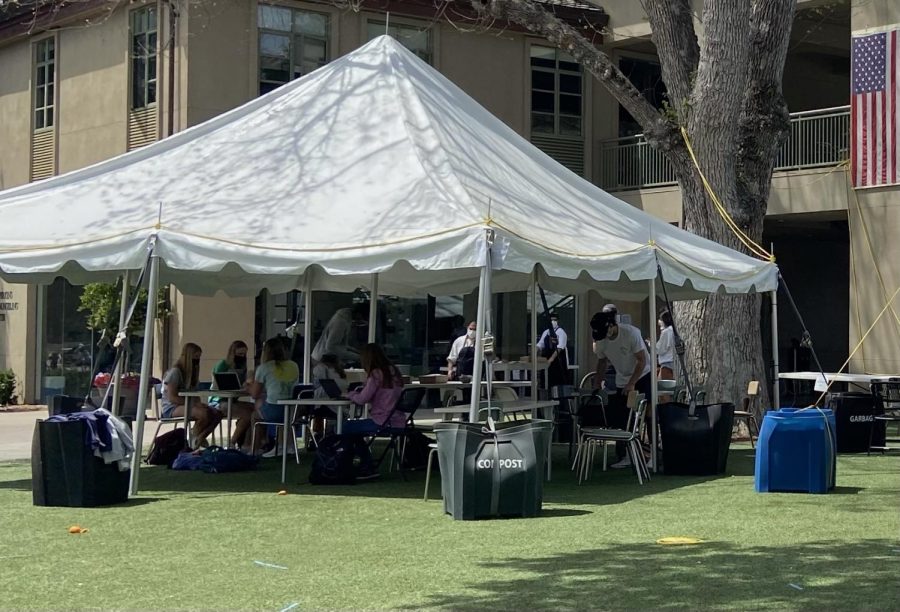Delay in Access Point Installations Caused Connection Issues During First Week Back
Students use outdoor learning spaces during classes and free periods to get work done. Staff photo: Tessa Frantz.
May 2, 2021
During the first week that 100% of students returned to campus, Menlo internet connection caused difficulties. Because of social distancing guidelines that limited the number of students allowed inside classrooms, outdoor learning spaces were designated for overflow from larger classes. Students were expected to use Zoom and Canvas to keep up with class from these outdoor spaces; however, network issues during the first few days of quad learning prevented some students from connecting with the rest of their class inside.
According to Director of Technology Gabe Schwarzer, the original issue with the network was due to a lack of wireless access points, or APs, on the quads. Because more students than usual were connecting to the existing APs on the quad attempting to run Zoom meetings, which require an increased bandwidth, more APs needed to be installed.
The technology department started to add more APs as soon as they learned that all students would be returning to campus. “We ordered 10 new APs right away and began planning how and where to install them,” Schwarzer said in an email to The Coat of Arms. “Unfortunately, due to an unexpected delay outside of Menlo’s control, we weren’t able to complete the installation by the time all of the students [returned.]” The AP installation was finished on April 23: seven new APs were added to the outdoor tents and 10 more are to be installed in various classrooms in the coming days. “Giving our students the best possible experience at Menlo is one of our highest priorities, [and] we’re confident that the wireless connectivity […] will run smoothly for the rest of the year,” Schwarzer said.
History teacher Katharine Hanson had students in outdoor learning spaces in all of her classes during the first week of having 100% students back on campus. She loved the idea of bringing all the students back and was excited to give all her students new opportunities to learn in every class. However, due to connection problems, she had to change her plans. “The logistics [of bringing all the students back] was kind of a leap of faith,” Hanson said. “[I’ve ended up] relinquishing control over the students outside this week and focused on the students in the classroom.” Hanson has been giving the students in outdoor learning spaces self-guided lesson plans by email until the connection problems are resolved.
Biology teacher Aaron Rupchand-Kokotek feels that there are benefits of having classes split between the classroom and outdoor learning spaces. “Zoom has been tricky outdoors, so it gives students a lot of independence with their work,” Rupchand-Kokotek said. He thinks this independence can be an asset, as it has taught students and teachers more flexibility. Rupchand-Kokotek knows students are likely to be more social and get less work done outside, but he thinks it’s worth it. “[Allowing students to connect with each other face-to-face] was one of the reasons we brought everyone back,” Rupchand-Kokotek said.
Still, sophomore Kate Kepner had trouble staying focused in class while outside due to the wifi issues. “[The] connection kept interrupting the class, so most teachers recommended asynchronous work outside,” Kepner said.
Like Kepner, junior Alexandre Acra felt that his classes and free period were disrupted by the connection issues. “I couldn’t do any homework during my free period and had to be asynchronous in some classes,” Acra said. “But it’s been a lot better [during the second week back].”




